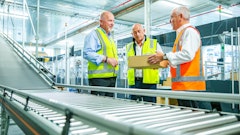
The wonderful world of warehousing (try saying that 5 times fast) has undergone significant transformations in recent years, driven largely by advancements in technology in the form of AI, automation and various project management tools. These advancements have not only benefited the operations but also enhanced the capabilities and well-being of the warehouse workforce.
Last year the warehouse automation market was valued at a 23 billion U.S. dollars. With higher demands and the fast-paced expectations of the modern supply chain, the importance of implementing solutions that can help enhance the overall efficiency of business operations and logistics has become all encompassing. Chris Corbin, CEO at Machines4U, says this revolution over the past few years has businesses relying on automation.
"This comes as a result of the growing pressure and demands for improving operational efficiency and leading more streamlined processes to fulfil the needs of businesses better. As demand grows, and trends for advanced technology rise, industries have increasingly become more dependent on automated warehouses to help with logistics and operation needs as a cost-effective solution," says Corbin. "An automated warehouse implements advanced technology as part of the day-to-day operations such as keeping track of inventory, picking and packing, to quality control through automated sensors, mobile robots, retrieval systems and more. For many businesses across the industrial sectors, this could prove to be a worthwhile investment as a response to the ever-increasing market demands where relying on manual labor alone may not provide the same efficiency and practicality needed to fulfil backlog and operation promises."
And we know the warehouse can be taxing; that's why wearable tech and autonomous robots have filled gaps within the labor pool where human workers might not want to work — or simply can't because of physical limitations. "Where the development of more advanced software solutions has significantly grown over the recent years, it is proving to be a major factor in the way businesses run more efficiently. For example, it could help cut back on labor-intensive tasks, while at the same time fostering new collaborative solutions where automation and manual labor can work hand in hand. More specifically, in the case of logistics-focused industries like manufacturing and e-commerce, sophisticated tools like AI or robotics have played a key role in improving the efficiency of project management and workload, helping streamline processes and optimizing daily operations across warehouse facilities to meet the ever-growing demands of the business," explains Corbin.
These new technologies have the power to ease the worries about ongoing labor shortages while also optimizing the way processes are done through project management. However, Corbin says there is a difference between leaning on these options and becoming fully dependent on them alone to make improvements. For businesses to consider a realistic approach, he says, they can implement and roll out proactively, a collaborative and educational process to push forward a higher level of productivity and efficiency in the workforce at large.

























